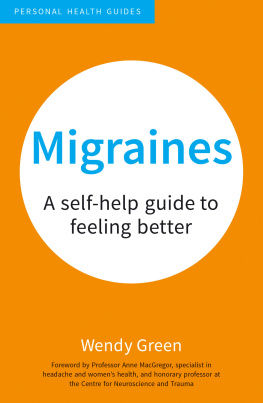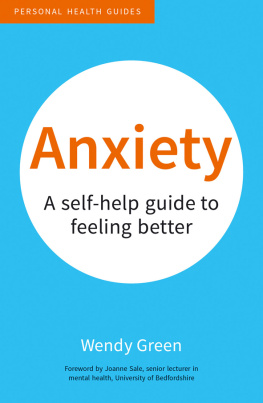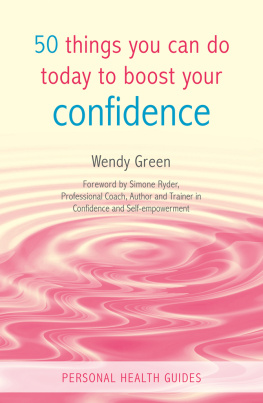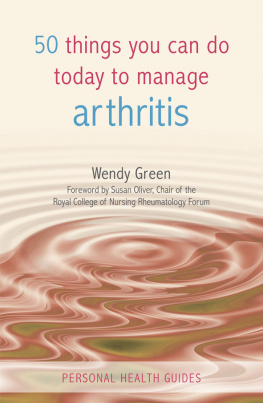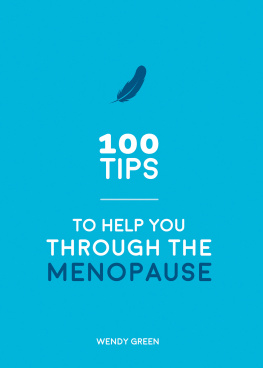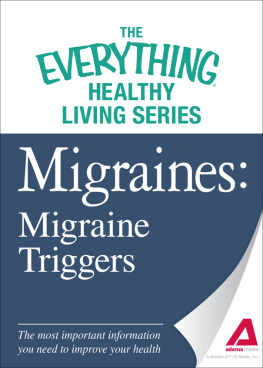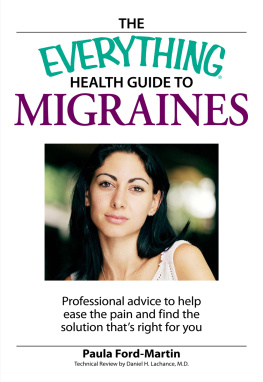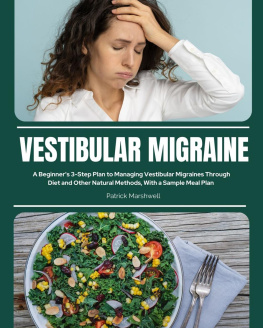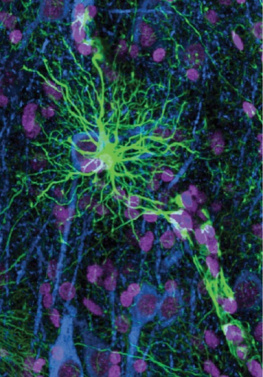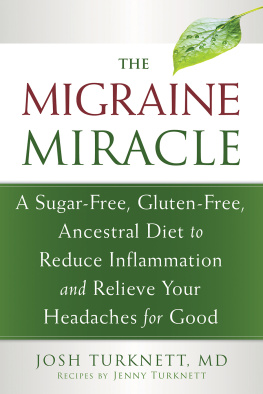MIGRAINES: A SELF-HELP GUIDE TO FEELING BETTER
First published in 2009 as 50 Things You Can Do Today to Manage Migraines
This revised edition copyright Wendy Green, 2016
All rights reserved.
No part of this book may be reproduced by any means, nor transmitted, nor translated into a machine language, without the written permission of the publishers.
Wendy Green has asserted her right to be identified as the author of this work in accordance with sections 77 and 78 of the Copyright, Designs and Patents Act 1988.
Condition of Sale
This book is sold subject to the condition that it shall not, by way of trade or otherwise, be lent, resold, hired out or otherwise circulated in any form of binding or cover other than that in which it is published and without a similar condition including this condition being imposed on the subsequent purchaser.
Vie Books is an imprint of Summersdale Publishers Ltd
Summersdale Publishers Ltd
46 West Street
Chichester
West Sussex
PO19 1RP
UK
www.summersdale.com
eISBN: 978-1-78372-721-6
Substantial discounts on bulk quantities of Summersdale books are available to corporations, professional associations and other organisations. For details telephone Summersdale Publishers on (+44-1243-771107), fax (+44-1243-786300) or email (nicky@summersdale.com).
Disclaimer
Every effort has been made to ensure that the information in this book is accurate and current at the time of publication. The author and the publisher cannot accept responsibility for any misuse or misunderstanding of any information contained herein, or any loss, damage or injury, be it health, financial or otherwise, suffered by any individual or group acting upon or relying on information contained herein. None of the opinions or suggestions in this book is intended to replace medical opinion. If you have concerns about your health, please seek professional advice.
To my husband Gordon thanks for being so supportive
Acknowledgements
I would like to thank Professor Anne MacGregor, specialist in headache and womens health and honorary professor at the Centre for Neuroscience and Trauma at the Blizard Institute of Cell and Molecular Science, Barts and the London School of Medicine and Dentistry, for her expert advice and help especially with regard to medical treatments for migraine. Id also like to thank Jennifer Barclay for commissioning the original book and Claire Plimmer for commissioning this edition. Im also grateful to Lucy York, Anna Martin, Laura Booth, Debbie Chapman and Jennifer Jahn for their very helpful editorial input.
Contents
Authors Note
I have suffered from migraines since the age of 15. At the start of my first attack, my field of vision must have been affected because I could only see half of everything I looked at. It was a terrifying experience. I initially thought I was somehow going blind until, of course, the aura faded away, to be replaced by a pulsating, one-sided headache. My next migraine did not happen until I was 22 and pregnant; again my field of vision was halved. Over the next 20 years I experienced only a few migraines but they were severe and left me incapacitated for days. During the menopause, my migraines increased first to one a month and then gradually they became a weekly event. My GP prescribed triptans, which worked once an attack was under way, but I still felt the effects for a few days afterwards, so I was keen to prevent them from happening in the first place.
I gradually realised that missing meals was a trigger, as was feeling stressed. I started making sure I never went too long without food and learned to recognise when I was feeling stressed and how to deal with it. I also began taking a supplement called 5HTP. Fairly quickly my attacks became less frequent.
Unfortunately, in 2013, my migraine frequency increased dramatically to as many as three a week. I tried numerous supplements, dietary changes, stress-management techniques and even visited a chiropractor, but nothing helped. In desperation I asked my GP if I could be referred for acupuncture. After receiving the four treatments covered by the NHS, I noticed that my migraines were both less frequent and less severe. However, once the treatment ended, they quickly worsened again, so I decided to pay privately for traditional Chinese acupuncture. Initially my migraines became more frequent and intense before improving dramatically. I found that having acupuncture every three weeks reduced the number of attacks to around three a month a huge improvement, but I still wanted to try to reduce them further; two months ago I also began taking 3 mg of melatonin every night before bed and have experienced just one migraine since. I am now hopeful that I have finally got my migraines under control without having to take the preventative anti-epileptic drug with worrying possible side effects, that I was prescribed by my consultant.
Migraine is an individual condition, and what works for one person may not work for another. In this book I provide an overview of the condition and present a wide variety of tips and advice, including dietary information and techniques from complementary therapies, to help fellow sufferers gain better control of their symptoms.
Throughout this book I refer to the condition as migraines; however, in medical literature it is often described in the singular, i.e. migraine.
Wendy Green
Foreword
Migraines affect different people in different ways. Some people find that no matter what they do to treat attacks, they are laid up for a day or so and unable to function normally; others can take a couple of painkillers and get on with their day. But no matter how mild or severe the attacks are or whether they seek medical advice, most people who suffer from migraines rely heavily on self-help strategies.
Using her own experience to draw upon, Wendy Green outlines the variety of treatments that are available over the counter, and also gives an overview of what is available from a GP. Research shows that sufferers are often satisfied with drugs that dont provide a great deal of benefit. Hence, it is important to explore the wealth of strategies that are available in order to ensure that you are receiving the optimum treatment.
It may not yet be possible to cure migraines, but it is possible to lead a normal life despite them.
Professor Anne MacGregor,
specialist in headache and womens health, and
honorary professor at the Centre for Neuroscience and Trauma
Introduction
Research suggests that, in the UK, around one in five women, one in twelve men and one in nine children suffer from migraines. Sufferers are most likely to experience their first attack during their childhood or teenage years. Roughly equal numbers of boys and girls experience migraines until puberty, when it becomes more common in girls. Overall, around six million people 10 per cent of the population are thought to suffer from the condition. On average, sufferers experience 13 attacks a year, yet some can go for several years without a migraine.
A study in 2007 reported that less than 50 per cent of people with migraine symptoms seek medical help. This is likely to be for various reasons. For example, some individuals may only have a few migraines in their lifetime, and do so without even realising it. Also, migraine can be inherited; 5060 per cent of migraineurs have a parent and 80 per cent have a sibling who also has the condition. Many such sufferers do not consult their GP because they believe little can be done and they tend to suffer in silence. Even when some sufferers do eventually visit their GP, their condition may be misdiagnosed as a tension or cluster headache.

